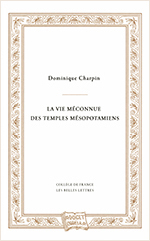DAILY LIFE IN A MESOPOTAMIAN TEMPLE
Dominique Charpin
(Les Belles Lettres, 256 pages, 2017)
A keen reflection on the incarnation of the sacred. —L’Histoire
Since the rediscovery of Mesopotamian civilization in the nineteenth century, archeological excavations and the unearthing of vast libraries of cuneiform tablets have allowed generations of scholars to reconstruct an image of this ancient world. Temples were prominent features of the city landscape and believed to be the earthly homes of the many deities of the Mesopotamian pantheon. In this book, Dominique Charpin, one of the world’s leading Assyriologists, takes a global approach to demonstrate that temples fulfilled many more functions than previously thought. Through close scrutiny of a diverse array of clues—an accounting document, a Sumerian hymn, an Akkadian epic, and a bronze ex-voto—he takes us on a fascinating investigation that sheds new light on everyday life at the temples.
Within their high walls, temples were long thought to be self-sufficient entities and a world unto themselves. Drawing on the latest discoveries, Charpin broadens this view and describes how different temples performed functions akin to those of our contemporary public or government agencies. The temples of Gula, goddess of medicine, he writes, served as healing centers where patients’ wounds were licked by dogs, and then dressed with herbal ointments. The temples of Samas, the god of justice, functioned as courthouses; the temples of the goddess Nungal served as jails; and those of the goddess Kittum were a sort of Bureau of Weights and Measures. In the chapter dedicated to the deities of writing, the goddess Nibasa and the god Nabu, Charpin discusses the training of scribes, the constitution of archives, and the establishment of libraries. And in the temples of the well-known Ishtar, the goddess of love and war, there was space for taverns and pleasure houses. Most important, key and sometimes mundane aspects of daily life—funerary practices, beer brewing, dairy production, and even the crafting of perfumes—were placed under the patronage of a deity or deities, whose temple served as the center of the activity.
At every turn, the author reminds us of the danger of projecting our own categories onto the past. It was not so much that temples fulfilled secular functions but that every human activity was imbued with a sacred dimension. One of the great pleasures of this book is following Charpin, step by step, on his deductive path. With his fluid style, he makes accessible a body of highly specialized research and offers to a larger audience a vivid portrait of the activities, conflicts, and concerns of people living in ancient Mesopotamia.
Dominique Charpin is Professor of Ancient Near Eastern History and Director of Studies at the École Pratique des Hautes Études, Sorbonne, Paris. An internationally recognized authority on the Ancient Near East, his books translated into English include Hammurabi of Babylon (I. B. Tauris, 2012), Reading and Writing in Babylon (Harvard University Press, 2010), and Writing, Law, and Kingship: Essays on Old Babylonian Mesopotamia (Chicago University Press, 2010).

